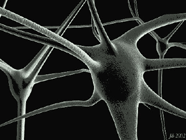
« PREVIOUS ENTRY
Survey: What music do you listen to while playing Grand Theft Auto?
NEXT ENTRY »
Death, taxes, and MMORPGs

Back in 1996, some Italian scientists wanted to study how the neurons in monkey brains planned and carried out movements. So they put probes into the monkeys and began monitoring their cerebral activity. Then something weird happened: A student came into the lab with an ice cream cone, and, while the monkeys watched, lifted it to his mouth. Simultaneously, the monkeys’ movement neurons all began firing. It was as if the monkeys themselves were lifting the cone to their own mouths.
The scientists had discovered “mirror neurons” — specialized brain cells that fire mimetically whenever an animal or human witnesses a movement. There’s a superb story on them in this week’s New York Times Science section, and it reports that researchers today now believe that mirror neurons are involved in some very complex behaviors. For example, they allow athletes to train themselves merely by watching others execute complex physical manouevers. And mirror neurons might even be involved in empathy — because when we see someone in distress our cells mirror their emotional state. As Giacomo Rizzolatti, one of the Italian neuroscientists who made the discovery, puts it: “Mirror neurons allow us to grasp the minds of others not through conceptual reasoning but through direct simulation. By feeling, not by thinking.” People who rank high on empathy scales tend to have particularly active mirror-neuron clusters in their brains.
But here’s where things get interesting. If our mirror neurons “learn” behavior by watching it, what happens when we view violent or pornographic media? The article ruminates on this a bit, noting that …
… a study in the January 2006 issue of Media Psychology found that when children watched violent television programs, mirror neurons, as well as several brain regions involved in aggression were activated, increasing the probability that the children would behave violently. [snip]
In yet another realm, mirror neurons are powerfully activated by pornography, several scientists said. For example, when a man watches another man have sexual intercourse with a woman, the observer’s mirror neurons spring into action. The vicarious thrill of watching sex, it turns out, is not so vicarious after all.
I tried to find the Media Psychology study mentioned above, but it doesn’t appear to be online — though some googling made me suspect it was done by Celia Heyes, a professor of psychology at University College London, who’s done a lot of work on the evolution of cognition. If anyone can find a copy of the paper, email and let me know: I’d love to read it!
I'm Clive Thompson, the author of Smarter Than You Think: How Technology is Changing Our Minds for the Better (Penguin Press). You can order the book now at Amazon, Barnes and Noble, Powells, Indiebound, or through your local bookstore! I'm also a contributing writer for the New York Times Magazine and a columnist for Wired magazine. Email is here or ping me via the antiquated form of AOL IM (pomeranian99).

ECHO
Erik Weissengruber
Vespaboy
Terri Senft
Tom Igoe
El Rey Del Art
Morgan Noel
Maura Johnston
Cori Eckert
Heather Gold
Andrew Hearst
Chris Allbritton
Bret Dawson
Michele Tepper
Sharyn November
Gail Jaitin
Barnaby Marshall
Frankly, I'd Rather Not
The Shifted Librarian
Ryan Bigge
Nick Denton
Howard Sherman's Nuggets
Serial Deviant
Ellen McDermott
Jeff Liu
Marc Kelsey
Chris Shieh
Iron Monkey
Diversions
Rob Toole
Donut Rock City
Ross Judson
Idle Words
J-Walk Blog
The Antic Muse
Tribblescape
Little Things
Jeff Heer
Abstract Dynamics
Snark Market
Plastic Bag
Sensory Impact
Incoming Signals
MemeFirst
MemoryCard
Majikthise
Ludonauts
Boing Boing
Slashdot
Atrios
Smart Mobs
Plastic
Ludology.org
The Feature
Gizmodo
game girl
Mindjack
Techdirt Wireless News
Corante Gaming blog
Corante Social Software blog
ECHO
SciTech Daily
Arts and Letters Daily
Textually.org
BlogPulse
Robots.net
Alan Reiter's Wireless Data Weblog
Brad DeLong
Viral Marketing Blog
Gameblogs
Slashdot Games